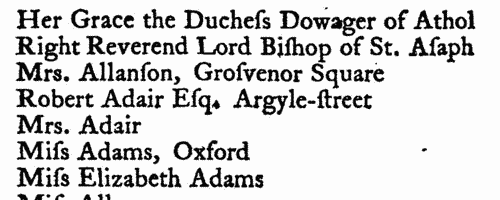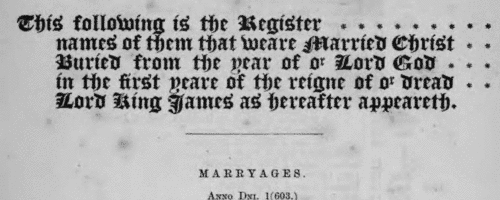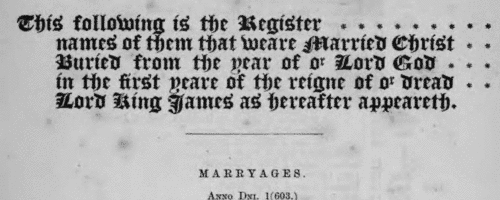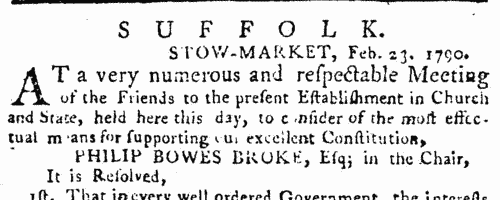Our indexes include entries for the spelling sparrow. In the period you have requested, we have the following 861 records (displaying 261 to 270):
 Masters of clerks and apprentices
(1785) Masters of clerks and apprentices
(1785)
Apprenticeship indentures and clerks' articles were subject to a 6d or 12d per pound stamp duty: the registers of the payments usually give the master's trade, address, and occupation, and the apprentice's name, as well as details of the date and length of the apprenticeship. 2 January to 31 December 1785. IR 1/32 | Sample scan, click to enlarge

|
Subscribers to Ann Yearsley's Poems on Several Occasions
(1785)
This book of poetry by 'Ann Yearsley, a Milkwoman of Bristol', received great critical acclaim and was rapidly reprinted. The third edition included these subscription lists for the first two editions. | Sample scan, click to enlarge

|
Wandsworth Baptisms
(1785)
The ancient parish of Wandsworth in Surrey comprised the single township of Wandsworth, including the hamlets of Garratt, Half Farthing and Summers Town. It lay in the archdeaconry of Surrey of the diocese of Winchester: unfortunately, few bishop's transcripts of Surrey parish registers survive earlier than 1800. Although the original parish registers of Wandsworth doubtless commenced in 1538, the volume(s) before 1603 had been lost by the 19th century. In 1889 a careful transcript by John Traviss Squire of the first three surviving registers was printed, and we have now indexed it year by year. The baptism registers from 1775 to 1788 normally give date of baptism, and the names of the child and its father and mother, as well as date of birth. | Sample scan, click to enlarge

|
Wandsworth Burials
(1786)
The ancient parish of Wandsworth in Surrey comprised the single township of Wandsworth, including the hamlets of Garratt, Half Farthing and Summers Town. It lay in the archdeaconry of Surrey of the diocese of Winchester: unfortunately, few bishop's transcripts of Surrey parish registers survive earlier than 1800. Although the original parish registers of Wandsworth doubtless commenced in 1538, the volume(s) before 1603 had been lost by the 19th century. In 1889 a careful transcript by John Traviss Squire of the first three surviving registers was printed, and we have now indexed it year by year. From 1760 onwards the burial registers contain date of burial, and full name; for the burial of children, the parents' names are only occasionally stated, just the word 'inf.' for infant; for the burial of wives, the husband's name; ages are given for adults. Extra details such as date or cause of death, address or occupation are almost never given. The burial registers are considerably more bulky than the baptism registers, because the burying ground was used by Dissenters, who formed a large part of the population. These include a French Protestant congregation that worshipped in a church (the registers of which do not survive) in a courtyard immediately opposite the parish church. The Quakers had a cemetery of their own. 'P.' or 'Paup.' indicates the burial of a pauper. | Sample scan, click to enlarge

|
 Masters of clerks and apprentices
(1787) Masters of clerks and apprentices
(1787)
Apprenticeship indentures and clerks' articles were subject to a 6d or 12d per pound stamp duty: the registers of the payments usually give the master's trade, address, and occupation, and the apprentice's name, as well as details of the date and length of the apprenticeship. 2 January to 31 December 1787. IR 1/33 | Sample scan, click to enlarge

|
 Masters of apprentices and clerks
(1788) Masters of apprentices and clerks
(1788)
Apprenticeship indentures and clerks' articles were subject to a 6d or 12d per pound stamp duty: the registers of the payments usually give the master's trade, address, and occupation, and the apprentice's name, as well as details of the date and length of the apprenticeship. 25 August to 31 December 1788. IR 1/34 | Sample scan, click to enlarge

|
 Apprentices and clerks
(1789) Apprentices and clerks
(1789)
Apprenticeship indentures and clerks' articles were subject to a 6d or 12d per pound stamp duty: the registers of the payments usually give the master's trade, address, and occupation, and the apprentice's name, as well as details of the date and length of the apprenticeship. 2 January to 31 December 1789. IR 1/34 | Sample scan, click to enlarge

|
 Masters of apprentices and clerks
(1789) Masters of apprentices and clerks
(1789)
Apprenticeship indentures and clerks' articles were subject to a 6d or 12d per pound stamp duty: the registers of the payments usually give the master's trade, address, and occupation, and the apprentice's name, as well as details of the date and length of the apprenticeship. 2 January to 31 December 1789. IR 1/34 | Sample scan, click to enlarge

|
Friends of the Establishment in Suffolk
(1790)
On 23 February 1790 at Stowmarket 'a very numerous and respectable Meeting of the Friends to the present Establishment in Church and State' was held 'to consider of the most effectual means for supporting our excellent Constitution'. Seven resolutions were passed, a key one being 'That confining public employments and places of trust to persons professing the Established Religion, is expedient for the public good; as justice and reason naturally point out a preference to those subjects whose attachment to the constitution is perfect and unequivocal, rather than to those who comply in part only with the laws of this country'. Well over 200 subscribed, their names and the resolutions being subsequently published in several London and provincial newspapers. In some cases full names are given, in others just surnames with initials. | Sample scan, click to enlarge

|
 Apprentices and clerks
(1791) Apprentices and clerks
(1791)
Apprenticeship indentures and clerks' articles were subject to a 6d or 12d per pound stamp duty: the registers of the payments usually give the master's trade, address, and occupation, and the apprentice's name, as well as details of the date and length of the apprenticeship. 5 March to 31 December 1791. IR 1/35 | Sample scan, click to enlarge

|
Research your ancestry, family history, genealogy and one-name study by direct access to original records and archives indexed by surname.












